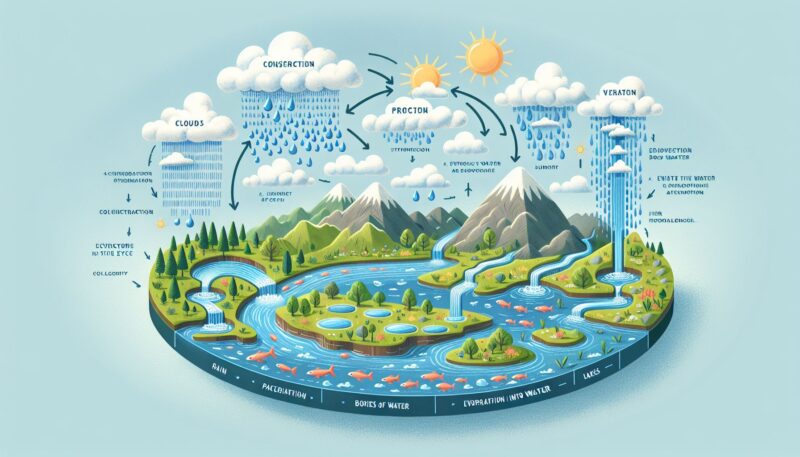Water is the most crucial element for life on Earth. The hydrologic cycle, also known as the water cycle, is a continuous global process through which water circulates through the planet’s hydrosphere, atmosphere, and lithosphere. This cycle is the central feature of Earth’s support system that allows for the existence of our diverse ecosystems and provides the water vital for human survival and well-being.
Understanding the Hydrologic Cycle
The hydrologic cycle is an intricate and dynamic system that describes how water moves and changes form across different parts of the Earth. It involves several key processes: precipitation, evaporation, transpiration, condensation, infiltration, percolation, runoff, and streamflow, which lead to various water occurrences such as groundwater, aquifers, rivers, lakes, oceans, glaciers, and icebergs.
Precipitation: The Sky’s Gift
Precipitation is the general term for any liquid or frozen water that forms in the atmosphere and falls to the ground. This includes rain, snow, sleet, and hail. Precipitation occurs when water vapor in the air condenses into larger droplets or ice crystals heavy enough to fall to Earth due to gravity.
Evaporation: From Liquid to Vapor
Evaporation is the process by which water transitions from a liquid state on the Earth’s surface to a vapor state in the atmosphere. This occurs when energy (usually from the sun) heats water in rivers, lakes, or oceans, causing water molecules to break free and rise into the atmosphere.
Transpiration: Nature’s Respiration
Transpiration is a critical part of water movement within ecosystems. It is the process by which plants lose water vapor through tiny openings in their leaves called stomata. This plays a crucial role in the hydrologic cycle, as it contributes to the amount of moisture in the atmosphere.
Condensation: Cloud Formation
Condensation is when water vapor in the air cools and changes back into liquid droplets. These tiny droplets of water form clouds and fog in the atmosphere. As these droplets collect and grow larger, they eventually fall as precipitation, completing the cycle.
Infiltration and Percolation: Earth’s Thirst
Infiltration is the downward movement of water from the surface into the soil. When water on the ground seeps into the soil, it’s called infiltration. Percolation is a deeper extension of infiltration, where the water moves further down through the soil layers and substrata.
Runoff and Streamflow: The Drift Back to the Sea
Runoff occurs when water from precipitation flows over the land’s surface towards streams, rivers, lakes, or the ocean. Streamflow is the water that flows within these streams and rivers. When precipitation exceeds percolation, infiltration, and evaporation, runoff ensures the return of water to the oceans.
Groundwater and Aquifers: The Hidden Treasure
Not all water runs off into rivers; some of it percolates through the soil, becoming groundwater. This water can then move through aquifers, which are layers of porous rock, sand, or gravel saturated with water. Groundwater is often a significant water source for both human use and ecosystem support.
The Cycle’s Influence on Climate and Weather
The hydrologic cycle is integrally connected to climate and weather patterns. It impacts environmental and climatic changes, affecting everything from local weather events to global climate shifts. Its relevance spans across wide-ranging facets including agriculture, forestry, urban planning, and environmental conservation.
Human Impact on the Hydrologic Cycle
Human activities can significantly impact the hydrologic cycle. Over-extraction of groundwater, deforestation, urbanization, and pollution all alter components of the cycle, sometimes leading to devastating effects such as reduced water quality, altered precipitation patterns, and the exacerbation of extreme weather events.
Water Resources and Human Use
Considering the vital importance of water, managing our water resources sustainably is essential. This includes ensuring safe and adequate water supply for drinking, agriculture, and industry, while also protecting natural ecosystems.
Water Treatment and Distribution
For human consumption, water treatment is crucial. Processes such as filtration, disinfection, chlorination, ozonation, and reverse osmosis, among others, ensure safety in water supply when managed correctly. Water distribution systems then carry this water to various consumers, relying on a complex network of pipes, pumps, reservoirs, and treatment facilities.
Water Scarcity and Conservation
Despite the abundance of water on our planet, water scarcity affects large parts of the world’s population, often due to unequal distribution, poor management, or extreme weather conditions like drought. Conservation measures, including rainwater harvesting, greywater reuse, and reducing individual water footprints, are ways to mitigate this issue.
The Role of International Water Diplomacy
When it comes to shared water resources, the potential for conflict increases, necessitating water diplomacy. Countries and regions must engage in discussions to ensure equitable and sustainable use of transboundary water resources to prevent conflicts and promote cooperation.
The Future of Earth’s Water
Climate change is altering the hydrologic cycle, bringing about changes in precipitation patterns, increasing evaporation rates, and melting ice reserves. The sustainability of future water resources hinges on our ability to understand, value, and manage the components of the hydrologic cycle.
Conclusion
The hydrologic cycle is a marvel of nature, an engine that sustains life on our planet. It is a continuous, self-supporting process that is both affected by and affects the Earth’s ecosystems. Understanding its components and functioning is not merely an academic pursuit but a necessary endeavor to preserve the wellbeing of all life forms on Earth and the ecosystems they depend on.
Awareness of the hydrologic cycle and its importance can guide conservation efforts, improve water management, and ensure that future generations inherit a planet with plentiful and clean water resources. From individual actions to global policies, the protection and sustainable management of our water resources is a shared responsibility, vital for the survival of our species and the health of our planet.
Educational sources for further understanding and insight into the hydrologic cycle and its global significance include:
- “Water in the Balance” by the International Water Management Institute: IWMI
- “The Water Cycle” by the United States Geological Survey: USGS Water Science School
